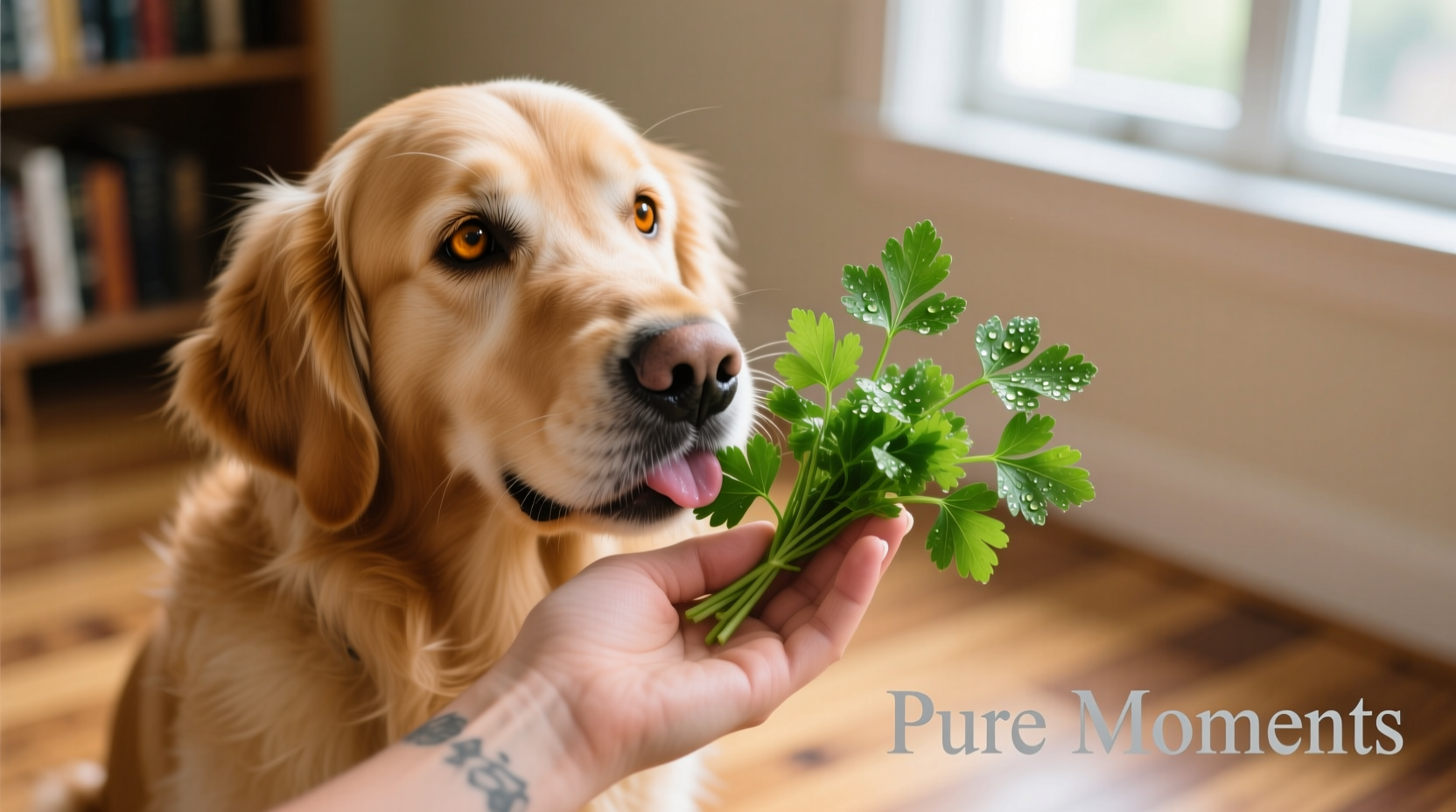As a pet owner, you've likely wondered whether that sprig of parsley on your dinner plate is safe for your curious canine. The good news is that this common herb isn't toxic to dogs and offers several potential health benefits when given in appropriate quantities. Unlike many human foods that pose serious risks to dogs, parsley falls into the 'generally safe' category—but with important caveats that every responsible pet owner should understand before sharing this kitchen staple with their four-legged friend.
Understanding Parsley Safety for Dogs
When evaluating whether parsley and dogs can coexist safely, veterinary nutritionists emphasize that moderation is key. According to the American Society for the Prevention of Cruelty to Animals (ASPCA), parsley ranks as non-toxic for canines, making it one of the safer herbs to share with your pet. However, this doesn't mean unlimited access is recommended. The active compound myristicin, present in higher concentrations in parsley seeds and roots, can cause digestive upset in large quantities.
Most veterinary professionals suggest limiting parsley to no more than one teaspoon of fresh, chopped parsley per 20 pounds of body weight daily. This conservative approach ensures dogs receive potential benefits without risking adverse effects. Puppies, senior dogs, and those with pre-existing health conditions require even more careful consideration before introducing parsley into their diet.
| Herb Type | Dog Safety Rating | Recommended Maximum | Special Considerations |
|---|---|---|---|
| Fresh Parsley | Generally Safe | 1 tsp per 20 lbs daily | Avoid for kidney issues |
| Parsley Seeds | Use Caution | Not recommended | Higher myristicin content |
| Dried Parsley | Generally Safe | 1/4 tsp per 20 lbs daily | More concentrated than fresh |
| Parsley Root | Use Caution | Not recommended | Higher myristicin content |
Health Benefits of Parsley for Dogs
When incorporated responsibly into your dog's diet, parsley offers several potential health advantages that extend beyond simply being non-toxic. This nutrient-dense herb serves as a natural source of essential vitamins and minerals that support canine wellbeing.
Natural breath freshener - The chlorophyll in parsley helps neutralize odors in your dog's digestive tract, providing a more effective solution than commercial breath mints that merely mask odors. Many pet owners notice improved breath within 24-48 hours of introducing small amounts of parsley.
Vitamin powerhouse - Parsley contains significant amounts of vitamin K (essential for blood clotting), vitamin C (an antioxidant), and vitamin A (important for vision and immune function). These nutrients complement a balanced canine diet, though they shouldn't replace complete and balanced dog food.
Digestive support - The dietary fiber in parsley can aid digestion when given in appropriate amounts. Some holistic veterinarians recommend small quantities of parsley for dogs experiencing mild digestive upset, though this should never replace professional veterinary care for persistent issues.
Safe Administration Methods
How you introduce parsley to your dog's diet matters as much as the quantity. Follow these evidence-based methods to maximize benefits while minimizing risks:
Fresh is best - Use organic, thoroughly washed parsley to avoid pesticide exposure. Chop finely to prevent choking hazards, especially for small breeds. Mix into regular meals rather than offering as a separate treat to ensure proper portion control.
Parsley tea alternative - For dogs reluctant to eat herbs, steep one teaspoon of fresh parsley in hot water for 5-10 minutes, then cool completely. Add one tablespoon of this tea per 20 pounds of body weight to your dog's water bowl. This method provides benefits with precise dosage control.
Avoid concentrated supplements - Commercial parsley supplements for dogs often contain higher concentrations than appropriate. The American Kennel Club advises consulting your veterinarian before using any herbal supplements, as they may interact with medications or exacerbate certain health conditions.

Important Limitations and Precautions
While parsley offers potential benefits, specific circumstances require caution or complete avoidance. Understanding these context boundaries ensures you make informed decisions for your individual dog:
Kidney disease considerations - Dogs with kidney problems should avoid parsley due to its naturally high potassium content. The University of California, Davis School of Veterinary Medicine notes that excessive potassium can strain compromised kidneys, potentially worsening the condition.
Medication interactions - Parsley may interact with certain medications, particularly diuretics, blood thinners, and diabetes medications. The herb's vitamin K content can interfere with blood-thinning medications like warfarin, while its natural diuretic properties may amplify prescription diuretics.
Pregnant or nursing dogs - Avoid giving parsley to pregnant or nursing dogs. Historical veterinary records indicate that large quantities of parsley may stimulate uterine contractions, potentially leading to complications. While modern studies are limited, most veterinarians recommend erring on the side of caution.
When to Consult Your Veterinarian
While small amounts of parsley are generally safe, certain situations warrant professional veterinary advice before introducing this herb to your dog's diet:
- Your dog has pre-existing kidney or liver conditions
- Your dog takes prescription medications regularly
- Your dog shows signs of digestive upset after consuming parsley
- You're considering parsley as a treatment for a specific health condition
Remember that while parsley may offer supplementary benefits, it should never replace proper veterinary care for diagnosed health conditions. The American Veterinary Medical Association emphasizes that herbal remedies should complement—not substitute—conventional veterinary medicine.
Alternative Herbs for Canine Health
If parsley isn't suitable for your dog, several other herbs provide similar benefits with different risk profiles:
Mint - Offers similar breath-freshening properties with lower risk of digestive upset. Use sparingly as large amounts may cause heartburn.
Basil - Contains antioxidants and has mild anti-inflammatory properties. Generally well-tolerated by most dogs in small quantities.
Cilantro - Provides similar vitamin content to parsley with lower myristicin levels, making it potentially safer for dogs with sensitive stomachs.
Always introduce new herbs one at a time and monitor your dog for any adverse reactions during the first 24-48 hours.
Frequently Asked Questions
Can puppies eat parsley?
Puppies can consume very small amounts of parsley, but should be introduced to it cautiously. Their developing digestive systems are more sensitive, so limit to 1/8 teaspoon chopped fresh parsley per 10 pounds of body weight, no more than twice weekly. Consult your veterinarian before introducing any new foods to puppies under 6 months old.
How much parsley is toxic to dogs?
Parsley isn't considered toxic to dogs in normal culinary amounts, but excessive consumption (more than 1 tablespoon per 20 pounds of body weight daily) may cause digestive upset, including vomiting and diarrhea. The seeds and roots contain higher concentrations of myristicin, which in very large quantities could potentially cause more serious issues, though documented cases of parsley poisoning in dogs are extremely rare.
Can dogs eat parsley and garlic together?
No, dogs should never eat parsley and garlic together. While parsley alone is safe in moderation, garlic belongs to the Allium family and is toxic to dogs, potentially causing hemolytic anemia. Even small amounts of garlic can be harmful, so avoid any combination products containing both ingredients. Many commercial "dog breath" products mistakenly combine these, so always check ingredient labels carefully.
Is curly parsley safer than flat-leaf parsley for dogs?
Both curly and flat-leaf (Italian) parsley are equally safe for dogs when given in appropriate amounts. The main difference is flavor intensity, with flat-leaf parsley having a stronger taste that some dogs may reject. Nutritionally, they're very similar, though flat-leaf parsley contains slightly higher concentrations of vitamins and myristicin. Choose based on your dog's preference rather than safety concerns.
Can parsley help with my dog's bad breath?
Yes, parsley can help freshen your dog's breath naturally due to its chlorophyll content, which neutralizes odor-causing compounds. For best results, give 1 teaspoon of fresh chopped parsley per 20 pounds of body weight daily mixed with food. However, persistent bad breath often indicates dental disease or other health issues, so consult your veterinarian if the problem continues despite dietary changes.











 浙公网安备
33010002000092号
浙公网安备
33010002000092号 浙B2-20120091-4
浙B2-20120091-4